It would be hard to define an advanced rugby player. In my opinion it is a player who has reached a fairly high standard, a players who is very experienced at the game and a player who is on top of their fitness demands. In addition I feel that an advanced player is always willing to pursue that extra few yards of pace, that extra ounce of power in order to achieve their full potential.
Specific Position Training
In this section I am going to concentrate of individual fitness that is more position specific. Everything that has been mentioned before in the others articles are fitness drills for any player of any position. To enable a player to get better at his/her game then specificity needs to come into their training methods.
Prop
Props today are normally the heaviest players on the field. They have powerful legs, a strong back and solid neck and traps. Weights exercises such as squats, hamstring curls, dead lifts, shrugs, rows and military press will allow props to strengthen these areas. However, props today need to be very mobile so good endurance also needs to be worked on; some of the best props in the world have a very fast 40 meter time yet weigh 250 pounds plus.
 Second Row
Second Row
Stereotypically the tallest on the field, second row players require a vast vertical jump for line out and solid leg power for scrummaging. Squats, dead lifts and calf raises all provide the leg power and plyometrics helps to improve the vertical jump.
Back Row
High levels of both strength and endurance are a must for all back row players. An all round weights regimen aimed at the upper body as well as high levels of intensity training enables back row players perform their role as tacklers and ball winners in loose play, as well as players to make those hard yards in attack.
Scrum Half
Nimble and agile, a scrum half requires exceptional speed off the mark as well as excellent endurance in order to keep up with play. Sprint training and interval training must be the priority for all scrum halves. A good all round weights training program is a must as scrum-halves are usually the first in line when it comes to being tackled whilst stationary! Make your own workout program, click here!
Fly Half
The QB of rugby needs to have high all round levels to fitness in all departments. Being able to make match winning decisions during the 79th minute of a game is a lot easier when you are on top of your fitness. Many top fly halves spend a lot of time doing low rep/ high weight leg weights to provided greater distance to kicks. The lunge is a common exercise for this. Fly halves need to have great speed and therefore sprint training and plyometrics need to be high on any training agenda.
Inside Centres
Inside centres today have different builds and this is normally reflected by the style of rugby a particular team plays. Some inside centres are stocky and powerful with good top speed. Some are smaller and slighter yet are more playmakers. An ideal would be a mixture between the two. In my opinion an inside centre should have a strong upper body for hard tackling and "crash ball" moves yet also have the speed to finish off moves once the defence is broken. Therefore weights geared toward the upper body and plenty on sprint training/ plyometrics should be undertaken.
Outside Centres
Outside Centres are commonly slighter than inside centres as this position is geared toward sprinting rather than power. Outside centres need plenty of sprint training and plyometrics yet sound upper body strength for tackling. An adequate level of endurance also needs to be achieved as outside centres have the furthest to travel than any other player when re-aligning for defence.
Wingers
 Sprint train, sprint train and sprint train. Scoring opportunities are sometimes few and far between and therefore any slight chance needs to be scored. Being faster than your opposite winger is such a huge advantage and a vast mental advantage for any team. Plyometrics and sprint training are the key drills for wingers. Weights training does help but if this hinders your speed then stop. Players like Jonah Lomu were born big and fast, some of us have to make do with just one of these characteristics.
Sprint train, sprint train and sprint train. Scoring opportunities are sometimes few and far between and therefore any slight chance needs to be scored. Being faster than your opposite winger is such a huge advantage and a vast mental advantage for any team. Plyometrics and sprint training are the key drills for wingers. Weights training does help but if this hinders your speed then stop. Players like Jonah Lomu were born big and fast, some of us have to make do with just one of these characteristics.
Full Back
Another position where speed is a necessity. Fullbacks need to fast when they hit the line of attack and excellent at sprinting into cover defence positions. Therefore sprint training and plyometrics as well as good strength for tackling. Another position where good leg training can aid in kicking performance.
NOTE: This is part three, click here for part one!
Thanks,
